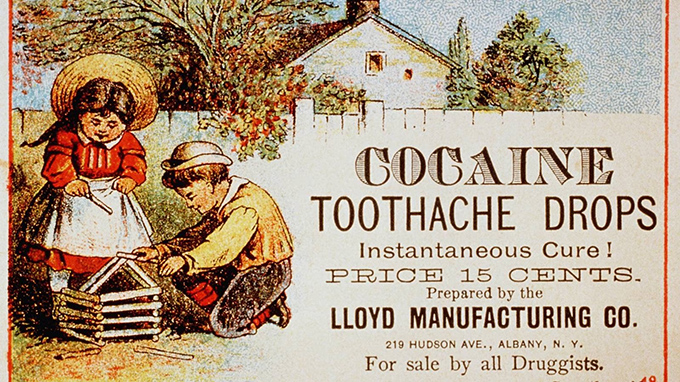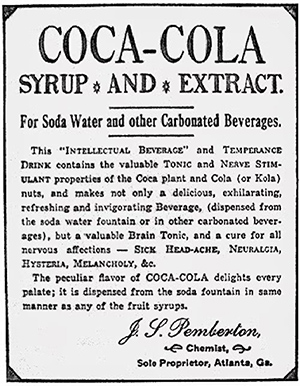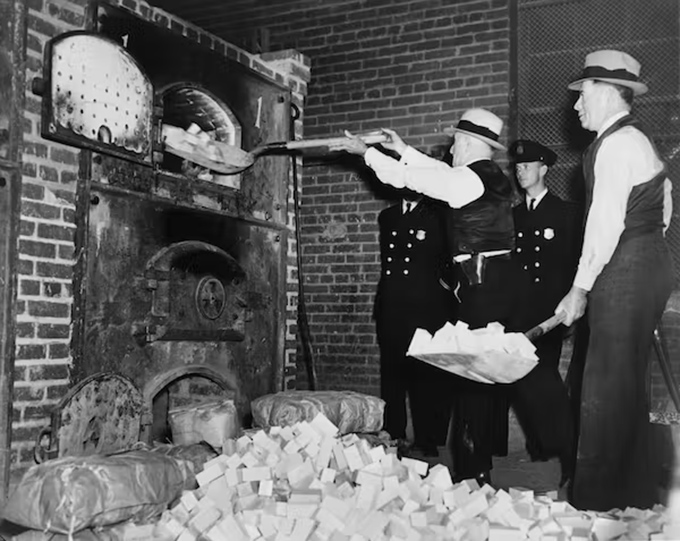
Many of the drugs currently being abused began their careers as “extremely useful” and beneficial drugs. This is the case of heroin, cocaine, cannabis or even amphetamines, among others .
A little throwback to the most famous substances, when the uses were legal and even popular. What were their “virtues”?
Cannabis and hashish, good for everything
Although widely used since ancient times in many cultures, cannabis was only recently introduced to Western medicine by Irish physician William Brooke O’Shaughnessey.
This Calcutta Medical College professor published the first article in 1839 describing its anticonvulsant properties. After returning to London in 1842, he came into contact with pharmacist Peter Squire, who produced the first commercial cannabis extract – sold as “Squire’s Extract”.
Subsequently, Sir John Russell Reynolds , personal physician to Queen Victoria of England (he would prescribe it for her, moreover), published in 1890, in the journal The Lancet , an article summarizing his thirty years of clinical experience with the hashish in the treatment of insomnia , neuralgia, headache, epilepsy or dysmenorrhea among other disorders .
At the end of the 19th century , cannabis or hashish, in different forms, was widely used and had established itself in all Western pharmacopoeias. Its therapeutic use will however decline after its withdrawal from the British Pharmacopoeia in 1932.
Freud, coca and depression
Cocaine, an alkaloid from the coca plant ( Erythroxylon coca ) isolated in 1859 by the German chemist Albert Niemann, was marketed as a drug in the United States in 1882. It was then mainly recommended against dental pain in children and to treat toothache. drop .
But the real discoverer of its pharmacological properties is the father of psychoanalysis. Sigmund Freud, in his youth, was more inclined to research than to the practice of medicine, for which he seems to have had a real aversion.
In 1884, he came across an article by a German military doctor entitled “Importance and Psychological Effects of Cocaine”. Although he had never heard of this substance, he immediately saw its potential against certain mental illnesses.
From then on, Freud began his studies on cocaine . At first, he experiences it himself and notices an improvement in his depressive state, as well as an increase in his confidence and his ability to work. During his tests, he also noticed that his tongue and lips were numb after taking it and that it relieved pain in the oral mucosa and that caused by gingivitis.
 In 1884, he wrote his famous work Über Coca (“On coca”), in which he claimed that this substance was a very effective medicine for combating depression, eliminating gastric disorders of nervous origin and increasing physical and intellectual performance. . He also claimed that it was not habit-forming, no side effects, no vice …
In 1884, he wrote his famous work Über Coca (“On coca”), in which he claimed that this substance was a very effective medicine for combating depression, eliminating gastric disorders of nervous origin and increasing physical and intellectual performance. . He also claimed that it was not habit-forming, no side effects, no vice …
Then, after five proselytizing articles, the psychoanalyst operates a complete reversal. He will end up refusing to include it in his complete works, after having noted its undesirable effects – in particular the death of his friend and colleague Ernst Fleischl.
However, he recommends it to the ophthalmologist Carl Köller, who confirms its great effectiveness, diluted in eye drops, as an anesthetic in eye surgery such as cataracts .
With this discovery, medicine took a giant step forward and local anesthesia was born.
However, cocaine’s greatest “therapeutic” success came from its presence in a multitude of “miracle elixirs” sold around the turn of the century for their supposedly energizing and invigorating properties. The most famous of all was that of the Corsican chemist and pharmacist Angelo Mariani: a Bordeaux wine in which coca leaves were macerated, all patented under the name of “Vin Mariani”.
Mariani founded, in 1863, the first major industry based on coca, and even received a decoration from Pope Leo XIII for his merits towards humanity. The French drink is soon all the rage.
Interlude: Coca… Cola
In the United States, the pharmacist John Stith Pemberton created in 1886 a non-alcoholic substitute for Mariani wine – which he called “French Wine Coca”.

In 1886, Coca-Cola advertising was based on promoting its main ingredients: extracts of coca leaf and kola nut. In 1903, coca was replaced by caffeine. Wikimedia Commons
This nerve tonic and stimulant was reformulated the following year as “Coca-Cola”. The Coca-Cola Company was founded in 1886 and first marketed its product as a remedy for headaches and a stimulant and as a pleasant drink: “A medicinal intellectual and temperamental drink. »
While the Coca-Cola Company removed cocaine from its drink in 1903, replacing it with caffeine and decocainated coca leaves as a flavoring, some 69 other drinks in the United States still contained it in 1909.
Heroin, safer than morphine…
Heroin is originally developed to enhance the safety of the overly addictive opium alkaloid morphine – not as an analgesic agent .
Diacetylmorphine, its technical name, was synthesized in 1874 by chemist Alder Wright at St. Mary’s Hospital Medical School in London by treating morphine with organic acids. Despite its ability to lower blood pressure and respiratory rate, there is little clinical interest in it. Not more in the following years, when it turned out that it also calmed coughs and facilitated sleep in patients suffering from tuberculosis.
It is finally Heinrich Dreser, of the pharmaceutical company Friedrich Bayer & Co., who will be interested in diacetylmorphine. The first he sees in it a solution that is both more powerful for relieving pain and a more acceptable molecule than sulphurous morphine.
It was marketed in 1898 to soothe coughs. Dreser will describe this drug as a “heroic drug”… hence the commercial name that Bayer will use: “Heroin”. It then experienced rapid and worldwide commercial success, in particular as an antitussive .
Amphetamines… for nasal congestion
At the end of the 1920s, the commercial monopoly of Ephedra vulgaris , the plant from which ephedrine is derived , led to the scarcity and increase in the cost of this active ingredient. This leads to the development of therapeutic alternatives for the treatment of asthma and airway congestion.
Amphetamine, synthesized in 1887 by Japanese chemist Nagayoshi Nagai, is researched and marketed by Smith, Kline, and French Laboratories for use by inhalation as a nasal decongestant .
Its medical use reached its peak in the 1960s. In Great Britain, 2.5% of all official prescriptions in 1959 were preparations containing amphetamines… We then moved away from the initial use since these molecules were then recommended as anorectics (appetite suppressant), but also for the treatment of epilepsy, schizophrenia, depression, irritable bowel syndrome, multiple sclerosis, traumatic brain injury and sexual dysfunction.
Ecstasy, ketamine, etc.
Prototype of the “designer drug”, methylenedioxymethamphetamine (MDMA), commonly known as “ecstasy”, was created in 1914 in the German laboratory Merck as an appetite suppressant . It will never be marketed.
On the other hand, it was soon used for research purposes by the American Navy in the 1950s and 1960s, and to facilitate communication between psychotherapist and patient in the 1970s.
Other drugs that have arrived more recently in the recreational arsenal also come from the therapeutic world and more specifically from the world of anesthetics:
● phencyclidine, known on the illegal market as “angel dust”,
● ketamine , another general anesthetic used mainly in children and the elderly, and in veterinary surgery. It found recreational use (“Ketas”, “Special K”) when its psychedelic (dissociative mind-altering) effects were accidentally discovered in the 1990s,
● gamma-hydroxybutyrate (GHB) , or “liquid ecstasy”, still an anesthetic that was used in the treatment of cerebral edema and alcoholism and as an ingredient in food supplements in sports halls.
Medical uses yet questioned from the start
The addictive phenomena linked to the consumption of heroin and cocaine were already known in the first decades of the 20th century . The Pure Food and Drug Act of 1906 placed the first restrictions on the manufacture of both substances.
In 1914, cocaine became illegal in the United States following the Harrison Narcotic Control Act , and a decade later, in 1924, heroin was banned.

Finally, in 1937, the Marijuana Tax Act was published, which prohibited the consumption of cannabis, now included in the list of prohibited substances of the Convention on Narcotic Drugs in 1961.
All of them are clear examples, in the pharmaceutical metaphor, of the shift from “heroes” to “villains”.
Author Bios: Francisco Lopez-Munoz is Professor Titular de Farmacología y Vicerrector de Investigación y Ciencia at the Universidad Camilo José Cela and Cecilio Alamo Gonzalez is Catedrático Universitario de Farmacología at the University of Alcalá
